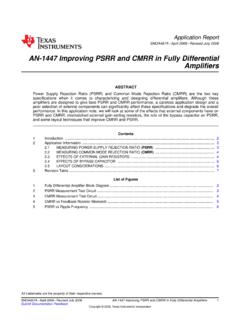Transcription of Guidelines for Measuring Audio Power Amplifier …
1 Application Report SLOA068 October 2001 Guidelines for Measuring Audio Power Amplifier performance Audio Power Amplifiers ABSTRACT This application note provides Guidelines for Measuring the data sheet parameters of Texas Instruments Audio Power amplifiers (APAs) using prefabricated evaluation modules (EVMs). The primary equipment used for the measurements consists of the System Two Audio measurement system by Audio Precision , a digital multimeter (DMM), and a dc Power supply. Contents 1 2 Basic Measurement 3 Interfacing to the Differential Input and BTL Output (TPA731 and TPA2000D1).
2 5 SE Input and SE Output (TPA0211 and TPA711)..6 Other Class-D RC Low-Pass 4 Total Harmonic Distortion Plus Noise (THD+N)..9 THD+N vs Output THD+N vs Maximum Output Power Maximum Input 5 Integrated Noise vs Signal-to-Noise 6 Gain and 7 8 Supply 9 Power Measurements and Related Efficiency Power Dissipated vs Power to the Crest Factor and Output 10 Measurement Effects of Improper Interfacing and THD+N Noise Gain and Phase Crosstalk Supply Rejection Efficiency 11 Audio Precision and System Two are trademarks of Audio Precision, Inc.
3 Other trademarks are the property of their respective owners. 1 SLOA068 Figures Figure 1. Audio Measurement Systems: (a) Class-AB APAs and (b) Filter-Free Class-D Figure 2. Differential Input BTL Output Measurement Figure 3. SE Input SE Output Measurement Figure 4. Measurement Low-Pass Filter Derivation Circuit Class-D Figure 5. THD+N Measurement Circuit Using the AP-II Measurement System: Figure 6. THD+N vs POUT for the TPA2001D1 and the Figure 7. THD+N vs Frequency for the TPA2001D1 and the Figure 8. Noise Measurement Figure 9.
4 Measured Results of Noise Circuit .. 13 Figure 10. Gain and Phase Measurement Figure 11. TPA731 Gain and Phase Figure 12. TPA2001D1 Gain and Phase Figure 13. Crosstalk Measurement Figure 14. Crosstalk Measurements ..17 Figure 15. PSRR and kSVR Measurement Figure 16. kSVR Filter 19 Figure 17. kSVR of the TPA2001D1 and Figure 18. Impact of CBYPASS on kSVR for the TPA711 Class-AB Figure 19. Efficiency Measurement Circuit for Class-AB and Class-D BTL Figure 20. Efficiency Graphs of the TPA731 and Figure 21. Graph of Power Dissipated vs Output Power ..24 Figure 22. Supply and Output Power vs CF for the TPA731 and Figure 23.
5 Effect of Generator Interface on APA Measurements, THD+N vs Power Shown ..27 Tables Table 1. Recommended Minimum Wire Size for Power Table 2. Typical RC Measurement Filter 9 Table 3. Efficiency Data for the TPA731 and Table 4. Power vs Crest 1 Introduction The primary goal of Audio measurements is to determine the performance of a device in the audible spectrum, 20 Hz to 20 kHz. Although most people do not hear frequencies below 50 Hz or above 17 kHz, the broad spectrum is an industry standard that allows a more accurate comparison of devices. The performance can be quickly analyzed, and only a few basic pieces of equipment are required.
6 A method for Measuring standard data sheet information for Audio Power amplifiers (APAs) is presented for several key parameters. These are: THD+N versus output Power Crosstalk versus frequency THD+N versus frequency Power supply rejection ratio Gain and phase versus frequency Supply ripple voltage rejection ratio Integrated noise Efficiency Signal-to-noise ratio Power dissipated in the device 2 Guidelines for Measuring Audio Power Amplifier performance SLOA068 The measurements in this application note were made using TI Plug-N-Play APA evaluation modules (EVMs).
7 The TPA2001D1 and TPA731 mono devices were used for most measurements. The TPA2001D2 and TPA0212 devices were used for the crosstalk measurements, which require a stereo device. Note that the measurements are dependent upon the layout of the printed-circuit board (PCB), particularly with class-D APAs. The graphs in the data sheet reflect typical specifications and were measured on test boards specifically designed to allow accuracy and ease of measurement. The measurements in this application note, however, were taken using circuits on EVMs that reflect real-world layout constraints. The measurements of a particular Audio circuit may vary from the typical specifications.
8 A large variance is usually indicative of a PCB layout or measurement system issue. 2 Basic Measurement System This application note focuses on methods that use the basic equipment listed below: Audio analyzer or spectrum analyzer Digital multimeter (DMM) Oscilloscope Twisted pair wires Signal generator Power resistor(s) Linear regulated Power supply Filter components EVM or other complete Audio circuit Figure 1 shows the block diagrams of basic measurement systems for class-AB and class-D amplifiers. A sine wave is normally used as the input signal since it consists of the fundamental frequency only (no other harmonics are present).
9 An analyzer is then connected to the APA output to measure the voltage output. The analyzer must be capable of Measuring the entire Audio bandwidth. A regulated dc Power supply is used to reduce the noise and distortion injected into the APA through the Power pins. A System Two Audio measurement system (AP-II) (Reference 1) by Audio Precision includes the signal generator and analyzer in one package. The generator output and Amplifier input must be ac-coupled. However, the EVMs already have the ac-coupling capacitors, (CIN), so no additional coupling is required. The generator output impedance should be low to avoid attenuating the test signal, and is important since the input resistance of APAs is not very high (about 10 k ).
10 Conversely the analyzer-input impedance should be high. The output impedance, ROUT, of the APA is normally in the hundreds of milli-ohms and can be ignored for all but the Power -related calculations. Figure 1(a) shows a class-AB Amplifier system, which is relatively simple because these amplifiers are linear their output signal is a linear representation of the input signal. They take analog signal input and produce analog signal output. These Amplifier circuits can be directly connected to the AP-II or other analyzer input. This is not true of the class-D Amplifier system shown in Figure 1(b), which requires low pass filters in most cases in order to measure the Audio output waveforms.










